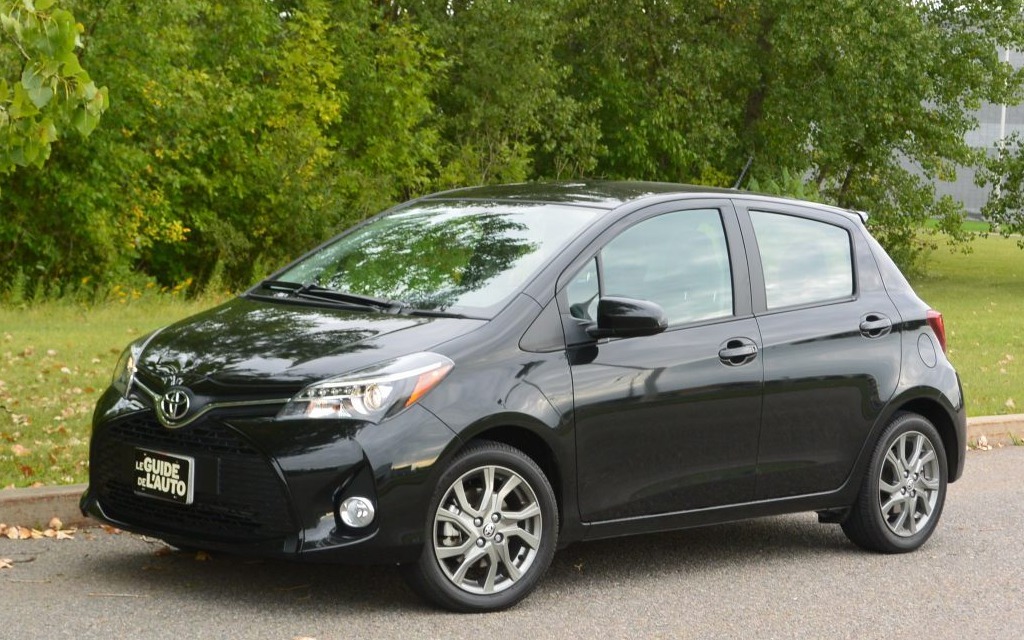2015 Toyota Yaris: Some New Ingredients, Some Leftovers

You don't have to be a car expert to know that the Yaris was lagging behind in the sub-compact category. Sure, its silhouette was attractive and its passenger compartment was relatively spacious, but the quality of the materials was disappointing at best and its meagre 1.5-litre engine lacked muscle. Toyota takes pride in its status as the world’s number one automaker and its reputation for manufacturing quality products, so all the criticism aimed at the Yaris really got under the skin of the brass at Toyota. Of course, the arrival of the Nissan Micra for less than $10,000 only made matters worse. Granted, the Micra isn’t the greatest thing since sliced bread, but the news of its launch put a frown on the faces at the world number one.
And let’s not forget the Hyundai Accent, updated about two years ago, featuring a modern silhouette and widely acclaimed 138-horsepower engine. To top it all off, Mazda is announcing a more modern, bigger and more powerful Mazda2.
Read also
In response to all of this pressure, the bosses at Toyota decided to adopt the same strategy that has worked for some other models: they looked to the specialized markets in the category. For example, the Tundra pick-up is not only assembled in the land of big trucks, Texas, but it was also developed there. To create a competitive sub-compact, Toyota turned to Europe, a market where sub-compacts abound. Even better, the Yaris was updated and improved by Toyota Europe, and is assembled in the north of France at the plant in Valenciennes. Basically, this sub-compact was entrusted to specialists in design and manufacturing.
This newcomer hasn’t undergone a complete makeover, however, but a mid-cycle review that targeted the silhouette and cabin presentation in particular, while making improvements to the platform and suspension. Unfortunately, they ignored the car’s primary flaw, but we’ll come back to that later.
Toyota Canada, are you sleeping?
This test drive started with some good news and some bad news. The good news was that the 2015 version was very quickly integrated into the manufacturer’s press fleet, which meant that we didn’t have to wait too long to test drive it. The bad news is that our car was black, which is problematic because a large part of this new version’s appeal is its front end, and specifically its spectacular black front grille that stands out from the rest of the body. The effect, however, is for all intents and purposes nullified when this black grille is paired with the black body – it has less visual punch. Thus, it’s no surprise that Toyota’s press site photos illustrate a slew of bright red Yaris units. I chose the pictures of the red and blue cars, and the difference is remarkable.
Be that as it may, you have a choice of seven colours to really help you appreciate the spectacular style of the front end. Note that this hatchback is still available in three- and five-door versions.
The dashboard used to have a reputation for poor quality, ultra hard plastics. This time, much better quality, softer materials were used. On the other hand, the dashboard layout remains identical with its triangular receptacle containing the main gauges. In fact, the only major change is the display screen that replaces the radio, which is now controlled using this screen. We test drove the most luxurious version, the SE, and the seats were covered with good quality material and stitching. Finally, both the front and rear seats are roomy.
Leftovers, anyone?
Modifying a car’s body, like modifying its passenger compartment, is relatively inexpensive as long as no major changes are made, but transforming the platform and mechanics is another story altogether. And since in this category a large part of the marketing revolves around pricing, significant out-of-cycle, production budget-busting mechanical transformations are out of the question. As a result, the engine and both transmissions are back, and that is not good news. The 1.5-litre four-cylinder developing 106 horsepower concedes several dozen horses to certain competitors. Its output is average, it's noisy and the ride is uninspiring. And I'm afraid there's more bad news: the engineers, or rather Toyota's accountants, decided to again use the five-speed manual transmission and the four-speed automatic. The latter constitutes the major annoyance. At worst, a CVT would have been a better solution.
Fortunately, although the platform has not been replaced, it has been made more rigid using multiple, strategically-placed welding points. Also note that, this year, all versions benefit from more rigid springs, firmer shocks and front and rear anti-roll bars that come factory standard. Finally, the steering’s ratio has been modified to make the power steering faster.
The ride? Meh...
As soon as you start the engine, its "economical" sound isn't exactly inspiring, and it becomes increasingly noisy as you upshift. Luckily, on the highway, the sound level inside the passenger compartment isn't too bad in part because of a more rigid body and an engine speed of less than 3,000 rpm. The ride is actually pretty relaxed, despite the look of a small, sporty car. Although its performance and feedback from the road didn't sweep us off our feet, the smallest Toyota on our market turned out to be a respectable, relatively comfortable tourer that offers decent, predictable handling. But this car's primary selling feature is its reliability.
The numerous changes made to the Yaris won’t help it climb to the top of the heap in its category. Compared to the best sub-compacts out there, it’s about middle of the pack. And if its new silhouette, more welcoming passenger compartment and roominess don't manage to win you over, there's always Toyota's trademark reliability and reassuring resale value.









